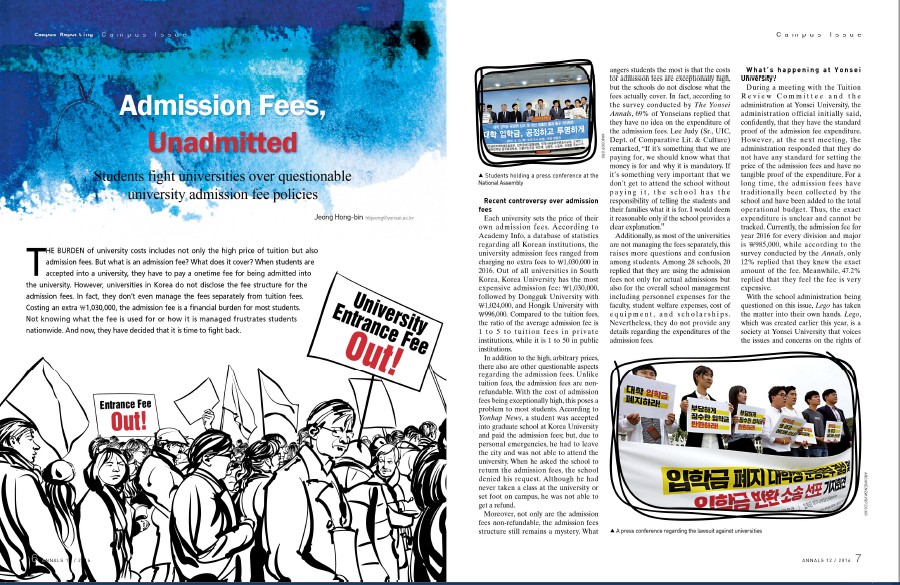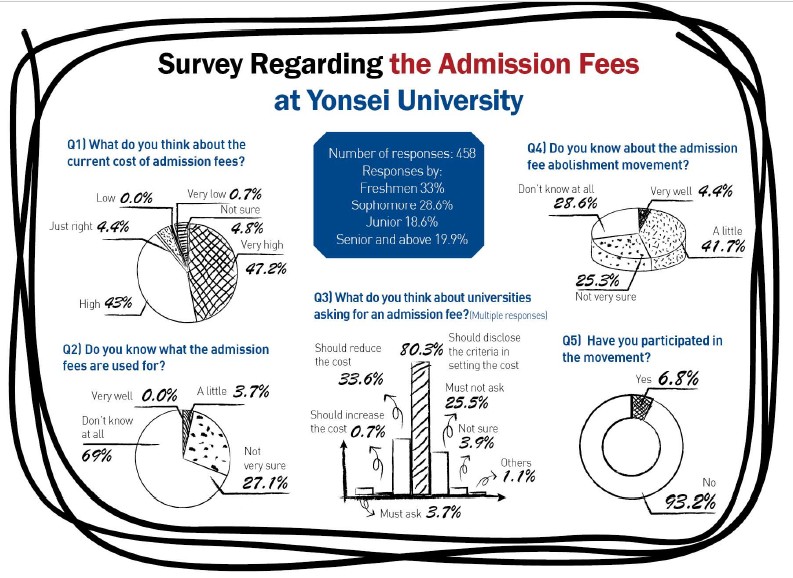Students fight universities over questionable university admission fee policies

THE BURDEN of university costs includes not only the high price of tuition but also admission fees. But what is an admission fee? What does it cover? When students are accepted into a university, they have to pay a onetime fee for being admitted into the university. However, universities in Korea do not disclose the fee structure for the admission fees. In fact, they don’t even manage the fees separately from tuition fees. Costing an extra ₩1,030,000, the admission fee is a financial burden for most students. Not knowing what the fee is used for or how it is managed frustrates students nationwide. And now, they have decided that it is time to fight back.
Recent controversy over admission fees
Each university sets the price of their own admission fees. According to Academy Info, a database of statistics regarding all Korean institutions, the university admission fees ranged from charging no extra fees to ₩1,030,000 in 2016. Out of all universities in South Korea, Korea University has the most expensive admission fee: 1,030,000, followed by Dongguk University with ₩1,024,000, and Hongik University with ₩996,000. Compared to the tuition fees, the ratio of the average admission fee is 1 to 5 to tuition fees in private institutions, while it is 1 to 50 in public institutions.
In addition to the high, arbitrary prices, there also are other questionable aspects regarding the admission fees. Unlike tuition fees, the admission fees are non-refundable. With the cost of admission fees being exceptionally high, this poses a problem to most students. According to Yonhap News, a student was accepted into graduate school at Korea University and paid the admission fees; but, due to personal emergencies, he had to leave the city and was not able to attend the university. When he asked the school to return the admission fees, the school denied his request. Although he had never taken a class at the university or set foot on campus, he was not able to get a refund.
Moreover, not only are the admission fees non-refundable, the admission fees structure still remains a mystery. What angers students the most is that the costs for admission fees are exceptionally high, but the schools do not disclose what the fees actually cover. In fact, according to the survey conducted by The Yonsei Annals, 69% of Yonseians replied that they have no idea on the expenditure of the admission fees. Lee Judy (Sr., UIC, Dept. of Comparative Lit. & Culture) remarked, “If it’s something that we are paying for, we should know what that money is for and why it is mandatory. If it’s something very important that we don’t get to attend the school without paying it, the school has the responsibility of telling the students and their families what it is for. I would deem it reasonable only if the school provides a clear explanation.”
Additionally, as most of the universities are not managing the fees separately, this raises more questions and confusion among students. Among 28 schools, 20 replied that they are using the admission fees not only for actual admissions but also for the overall school management including personnel expenses for the faculty, student welfare expenses, cost of equipment, and scholarships. Nevertheless, they do not provide any details regarding the expenditures of the admission fees.
What’s happening at Yonsei University?
During a meeting with the Tuition Review Committee and the administration at Yonsei University, the administration official initially said, confidently, that they have the standard proof of the admission fee expenditure. However, at the next meeting, the administration responded that they do not have any standard for setting the price of the admission fees and have no tangible proof of the expenditure. For a long time, the admission fees have traditionally been collected by the school and have been added to the total operational budget. Thus, the exact expenditure is unclear and cannot be tracked. Currently, the admission fee for year 2016 for every division and major is ₩985,000, while according to the survey conducted by the Annals, only 12% replied that they knew the exact amount of the fee. Meanwhile, 47.2% replied that they feel the fee is very expensive.
With the school administration being questioned on this issue, Lego has taken the matter into their own hands. Lego, which was created earlier this year, is a society at Yonsei University that voices the issues and concerns on the rights of education violated by the Yonsei administration and aims to stand up against them on behalf of the students. When they come across a problem with the administration, Lego first tries to address the issues on behalf of the student body, and then seeks to build a better community like “Lego” building blocks. Regarding entrance admission fees, Song Ha-ram (General Manager, Lego) responded, “Lego has led a signature-seeking campaign to abolish admission fees and pursue a lawsuit against the school. We have also made various posts on social media to raise awareness on the issue of admission fees among Yonsei University students.”
Furthermore, the National Human Rights Commission of Korea advises universities to establish specific standards on improving the objectivity of imposing illegitimate costs. There should be a clear standard in pricing the cost that has no specific purpose. Otherwise, the school, without having a limitation and standard, will excessively charge the students. In this respect, Lego has also held a press conference in front of the National Assembly on Oct. 18, 2016 to address this issue. Yet, as of November, Yonsei University has not responded to any of these issues, yet.

The movement of change
Starting in mid-September, a movement called “University Admission Fee Out” has sought to call out universities and demand them to stop receiving the admission fees from freshmen and to give back previously paid admission fees. The movement consists of 15 different universities that require students to pay these mysterious admission fees. The movement is currently protesting to find out what the true fee structure behind the admission fees are, especially what the collection of fees are being used for. They have asked to disclose the admission fees, but their request has been constantly refused. Since the summer break, the movement started gathering students from different universities to come together in efforts to make their voices heard.
Moreover, People’s Solitary for Participatory Democracy (PSPD), a civic group for a democratic society, Lawyers for Democratic Society and Cheong nyun ha da gathered together to solve the admission fee issue. The PSPD helped connect the civic group, the National Assembly and the media, while the Lawyers of Democratic Society led the lawsuit for this issue. Along with this cooperation, Korea University’s General Student Council, Star:zari and Cheong nyun ha da started the “University Admission Fee Out” movement. Star:zari called other General Student Councils of about 30 different universities around the nation that charge high admission fees and created a “Headquarter of Administration Abolishment University Student Movement,” which takes actions on behalf of the universities.
The “University Admission Fee Out” movement aims to get the admission fees back for each student, and prevent new incoming freshmen from paying these fees. Their goal is to sue the schools regarding this issue. Thus they are trying to raise money for lawyer costs, plaintiff costs, campaigning costs, and so on—a goal total of ₩5,000,000. In the university unit, they have gathered a total of 7,565 signatures and 9,729 people have filed a joint lawsuit against the universities. Currently, the signatures have been sent to the Education, Culture, Sports and Tourism Committee. The lawsuit was filed on Oct. 25, 2016. The movement has also applied to pass a legislation to abolish all admission fees and to prevent the improper admission fee collection from any university.
Among university students, there are mixed opinions on getting the admission fee back and abolishing the fees. Judy responded, “The students, under current circumstances, do deserve it back—where did that money go and why was it kept a secret? Maybe if the school disclosed such information, this wouldn’t be a problem.” However, another student expressed a different concern. Shin Dong-chan (Soph., Dept. of Political Science & Int. Studies) said, “I do agree that schools should in fact disclose the fees as they are exceptionally high; however, I am kind of scared that even if the school eliminates the admission fees, they might just increase the tuition and dormitory fees instead.”
The basis of the lawsuit consists of various aspects. Firstly, there are unjust profits earned due to overcharged admission fees. Thus, the universities have to return them back to the owners. In fact, the admission fees that were supposed to be used in administrating the freshmen were not used for that purpose. Secondly, the universities have abused their position to unfairly charge students. Comparing freshmen students and the university in terms of business, the schools hold the superior position. The schools have violated the law by using their superior position to create unfair fees. Lastly, there is an illegal act caused by the unfair, excessive fees. The students are paying more than ₩900,000 in admission fees without having any clear benefits or advantages. This kind of act is part of an illegal activity caused by overcharging.
According to Lee Seung-joon (General Manager, University Admission Fee Out Movement), the odds of winning the current lawsuit against the admission fees is unknown, but the more people who participate and fight against the schools regarding this issue, the more likely they are to win the case. Previously, in 2010, the public and private universities filed a lawsuit involving the removable fees for state-funded graduate schools; however, during the Supreme Court trial, it turned out unsuccessful. But, Seung-joon added, “In a way it was a successful lawsuit to the students because in the process, many students participated and expressed their opinions. It gathered hundreds of students’ attention and showed the unity of students. And this type of unity is what we expect out of this movement as well. The more the participation, the more likely our voices will be heard.”
Moreover, the movement has organized several protests to get their voices heard. One of the biggest movements happened at Seoul Station on Oct. 8, 2016, where students from all universities in Seoul came together to send their message and feelings towards the unfair admission fees.
* * *
The issue of admission fees has been in fact overlooked. This issue has not been highlighted until recently because freshmen usually do not doubt the mandatory reasons for paying the admission fees, while other students are liable to lose interest in the issue as they do not have to pay the fees again. However, students should realize the schools have not disclosed the fee structure behind the costs, and the schools could possibly have been taking advantage of them. And it is time for students to continue fighting back and standing up for their rights. We must promote this issue to parents, university students, and current high school students who will soon be attending universities, so that schools will finally understand the graveness of the problem and abolish the ambiguous admission fees—or disclose the expenditures of the admission fees, as students have the right to know.
Jeong Hong-bin
hbjeong@yonsei.ac.kr

